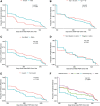Understanding Retention in Pre-Exposure Prophylaxis Care in the South: Insights from an Academic HIV Prevention Clinic
- PMID: 35172632
- PMCID: PMC9048170
- DOI: 10.1089/AID.2021.0177
Understanding Retention in Pre-Exposure Prophylaxis Care in the South: Insights from an Academic HIV Prevention Clinic
Abstract
HIV pre-exposure prophylaxis (PrEP) is poorly utilized in the southern United States. We examined PrEP retention in care and sexually transmitted infections (STIs) through a retrospective review of the Duke University PrEP Clinic from January 1, 2015 to October 15, 2019. We evaluated short-term (3 months), long-term (additional 8-12 months), and longitudinal retention in care in our clinic. Adjusted odds ratios (aOR) were generated to explore demographics associated with retention. Kaplan-Meier curves were generated to view retention longitudinally. STIs were examined at baseline (1 year before initial PrEP visit) and while retained in care. Of a total of 255 patients; 88% were men, 37% were black, and 73% were men who have sex with men (MSM). Short- and long-term retention in care were met by 130/237 (55%) and 80/217 (37%) patients, respectively. MSM were more likely to be retained in the short term (aOR = 5.22, 95% confidence interval [CI] = 1.57-17.32). Self-referred patients were more likely to be retained in the long term (aOR = 2.18, 95% CI = 1.12-4.23). Uninsured patients were less likely to be retained in the long term (aOR = 0.32, 95% CI = 0.11-0.91). STI diagnoses include 42 infections at baseline and 69 infections during follow-up. STI diagnosed while in PrEP care was associated with longer retention in care over time. Patients discontinue PrEP care over time and STIs were frequently encountered. Additional studies are needed to determine the best way to retain patients in HIV preventative care.
Keywords: HIV; persistence in care; pre-exposure prophylaxis; sexually transmitted infections.
Conflict of interest statement
M.S.M. received a grant from the Gilead Foundation paid to her institution.
Figures



References
-
- Centers for Disease Control and Prevention. Preexposure Prophylaxis for the Prevention of HIV Infection in the United States-2017 Update A Clinical Practice Guideline. Atlanta, Georgia, 2018.
Publication types
MeSH terms
Grants and funding
LinkOut - more resources
Full Text Sources
Medical
Miscellaneous
